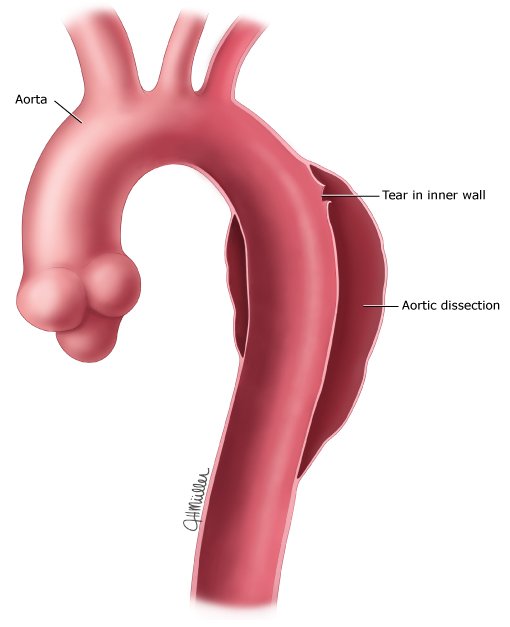Aortic Dissection
We can diagnose and treat this life-threatening condition.
We can diagnose and treat this life-threatening condition.
Aortic Dissection (AD) occurs when an injury to the innermost layer of the aorta allows blood to flow between the layers of the aortic wall, forcing the layers apart. In most cases, this is associated with a sudden onset of severe chest or back pain, often described as “tearing” in character.
AD is relatively rare, occurring at an estimated rate of three per 100,000 people per year. It is more common in males than females. The typical age at diagnosis is 63, with about 10% of cases occurring before the age of 40.

Consider a screening to see if you are at risk.
AD is more common in those with a history of high blood pressure, a number of connective tissue diseases that affect blood vessel wall strength including Marfan syndrome and Ehlers Danlos syndrome, a bicuspid aortic valve, and previous heart surgery. Major trauma, smoking, cocaine use, pregnancy, a thoracic aortic aneurysm, inflammation of arteries, and abnormal lipid levels are also associated with an increased risk.
The diagnosis is suspected based on symptoms with medical imaging, such as computed tomography, magnetic resonance imaging, or ultrasound used to confirm and further evaluate the dissection. The two main types are Stanford type A, which involves the first part of the aorta, and type B, which does not.
Depending on the severity and nature of the condition, there are differing treatments. Complicated dissections require an emergent operation either endovascular or open to repair the injury. If this is not the case, the primary treatment will be blood pressure control and if the pain goes away, then planning for a procedure can be done electively.
For “uncomplicated” aortic dissections, patients should undergo an elective repair at 14 days to 90 days after the tear occurs. The goal is to cover the tear in the aorta and restore normal flow. This repair is done because over time the torn aorta has a tendency to form a large aneurysm that is at high risk of rupture.
Pinellas Vascular is ready to assist you with your vascular condition or concern. Send us a message and we will get back with you quickly.